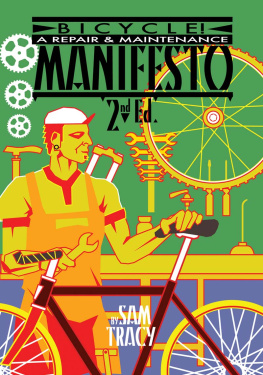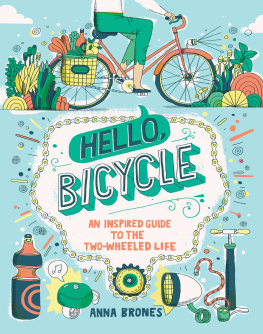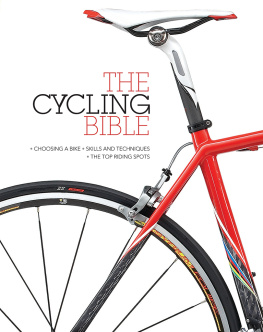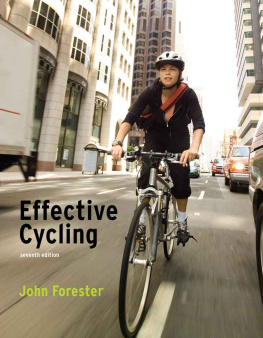Contents
PREFACE:
Women and the Bicycle
How to...
THE GIRLS BICYCLE HANDBOOK
EVERYTHING YOU NEED TO KNOW ABOUT LIFE ON TWO WHEELS
CAZ NICKLIN


New York London
2014 by Caz Nicklin
All rights reserved. No part of this book may be reproduced in any form or by any electronic or mechanical means, including information storage and retrieval systems, without permission in writing from the publisher, except by reviewers, who may quote brief passages in a review. Scanning, uploading, and electronic distribution of this book or the facilitation of the same without the permission of the publisher is prohibited.
Please purchase only authorized electronic editions, and do not participate in or encourage electronic piracy of copyrighted materials. Your support of the authors rights is appreciated.
Any member of educational institutions wishing to photocopy part or all of the work for classroom use or anthology should send inquiries to Permissions c/o Quercus Publishing Inc., 31 West 57th Street, 6th Floor, New York, NY 10019, or to .
ISBN 978-1-62365-150-3
Distributed in the United States and Canada by Random House Publisher Services
c/o Random House, 1745 Broadway
New York, NY 10019
www.quercus.com
Women and the Bicycle
Let me tell you what I think of bicycling. I think it has done more to emancipate women than anything else in the world. It gives women a feeling of freedom and self-reliance. I stand and rejoice every time I see a woman ride by on a wheel the picture of free, untrammeled womanhood.
Susan B. Anthony, American womens rights activist, 1896
The humble bicycle had a profound impact on the liberation of women. Initially, there was great objection to women riding bicyclesit was not deemed ladylike, and the brave few who cycled in the street were seen as outcasts or circus freaks. But, despite the disdain and disapproval, women persisted to cycle. The critics were fighting a losing battle.
By the 1890s, women were taking to their bicycles in droves in the US, France and in the UK, and it was this fast-spreading eagerness to ride the wheel that caused fundamental and long-awaited changes to what women wore. Pre-bicycle women were expected to dress a certain way: their everyday wear consisting of a tight and restrictive corset and huge, floor-length skirt, not to mention layers and layers of underwear and petticoats that could amount to as much as a stone in weight. Can you imagine cycling your commute in such attire?
No, thank you. Well, this is exactly what our Victorian ancestors thought and, after a surge of bicycling accidents due to the ridiculously unsuitable clothes, the dress reform movement came to a head.

The most significant change was women shedding their skirts and instead sporting bloomers to cycle in. Bloomers were voluminous shorts made from wool or tweed that puffed out to give a feminine feel but tapered just above the ankle to allow movement. They got their name from American feminist Amelia Bloomer, who had championed the idea of a divided skirt in the womens liberation paper The Lily in the early 1850s. The idea had been deemed absurd by most at the time, and it was not until some 30 years later, when the bicycle became more commonplace, that the bloomer finally had its day. The British Rational Dress Society fought tirelessly on the matter and in 1889 one member, Charlotte Carmichael Stope, made an impromptu speech on the subject of rational dress at a meeting of the British Association for the Advancement of Science, and it became a huge news story. The seed had been sown in womens minds, the skirts came off and the bloomers went onthe first real step toward women wearing pants.
Riding a bike gave women a chance to exercise and get out in the fresh airsuch simple pleasures that they were often denied. Women were seen as fragile, weak creatures and it was thought that physical exertion was bad for their health, despite the fact that many working-class women worked long hours in very physical jobs. Initially, women were believed to be far too delicate to handle these new machines and it was claimed that the cycling position would either arouse them (not allowed in Victorian times) or prevent them from having children. But women got a taste for the physical exhilarationthe sheer thrill of riding a bike outdoorsas well as realizing that exercise made them feel good, and eventually they stuck two Victorian fingers up at the stuffy conformists.
Cycling also allowed women to go places on their own, another fundamental freedom that, from a modern standpoint, it seems extraordinary to have had to live without. Young women of the middle and upper classes were not allowed to go anywhere by themselves and were always chaperoned, especially when meeting members of the opposite sex. But the bike enabled them to travel alone or at least cycle away from their chaperones! This was not a freedom exclusive to those with stature and moneyit also gave working-class women freedom and mobility, enabling them to get to school or work and to get out and socialize.
The bicycle gave women a taste of independence and freedom, and it made their minds, bodies and wills stronger. It was heralded as a freedom machine and seen by many suffragettes as a powerful force in the fight to get the vote. As Elizabeth Cady Stanton said, Woman is riding to suffrage on a bicycle.
HEROINES OF CYCLING
Blanche dAntigny (184074)
Blanche dAntigny, a star of French theater and opera, was one of the first women to be captured on canvas with a bicycle. Blanche did not hold back when it came to her personal life either, running away from home aged 14 with a lover and having a series of high-profile affairs throughout her short life. Women riding velocipedes in public were frowned upon in the early days and it was only the very plucky who dared to have a goFrench actresses being cited as the type of women that would.
Lady Harberton (18431911)
Lady Harberton, Florence Wallace Pomeroy, was the wife of a British Viscount and President of the Western Rational Dress Society and an avid cyclist. In 1898, when out for a bike ride, dressed boldly in bloomers and a short riding jacket, she stopped off for some lunch at the Hautboy Hotel, Ockham, Surrey. She was, however, refused entrance to the restaurant for indecent dress. The CTC (Cyclists Touring Club), still going today, attempted to sue the establishment for refusing food to a traveler but unfortunately lost the case. Hopefully, this did not stop Lady Harberton wearing her modern cycling get-up. Somehow, I doubt it did.















